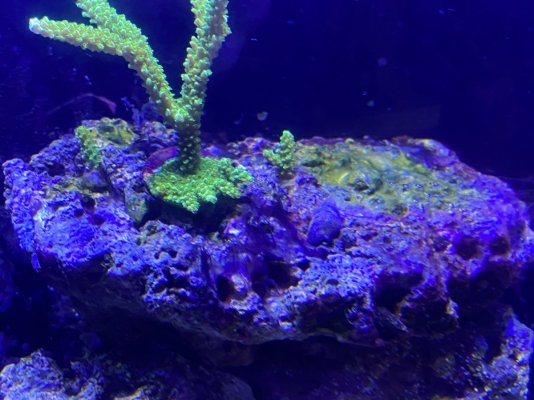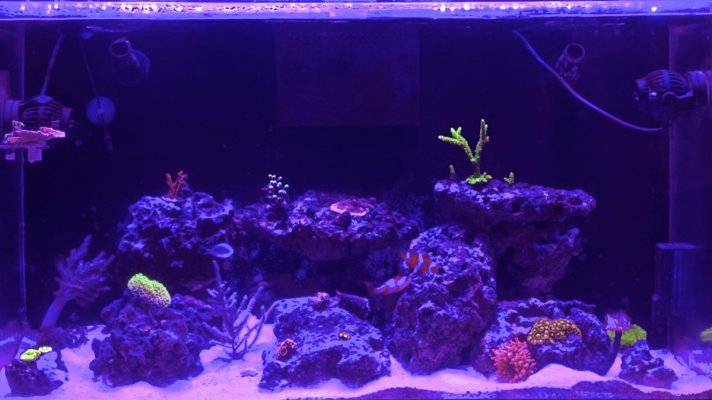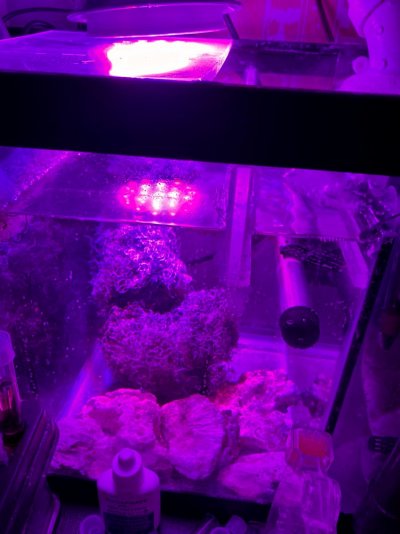Hi,
I have a 50gal mixed reef with fish. Currently, as the title says, I’m bottomed out on NO3 and PO4. I have chaeto and it’s growing in my 15 gal sump/fuge but it’s small… softball sized.. Photoperiod = 8h.
I’m still growing all kinds of algae in the DT: looks like dinos, two types of cyano, red and green, some black stuff, hair algae and god knows what else. So the NO3 and PO4 are being utilized by algae and reading 0.
I feed large pellets once per day and spot feed corals once per week and also drop larger shrimp pieces for the pistol and the RBTA. So minimal feeding, I’d say. I often broadcast feed live nano phytoplankton.
Skimmer is a dry skimmate, not overproducing. I run a small any of carbon. My fuge is often overrun with cyano or other blue-green slime.
The question is… how do I direct more of these resources to the coral and the chaeto and less to the nasty algae in the tank? If I increase the photoperiod of the chaeto, will that work? Or will I bottom out even more? Or maybe I decrease the chaeto photoperiod, but then the DT algae might take off! Either way I feel screwed.
What do I do? Any advice? Here are some photos of my system
NO3: 0 (salifert and api)
PO4: 0.00 (Hanna)
Alk: 8.4-9.1
Ca: 485
Mag: 1350-1400
Lights: reefbreeders 36 V2+
PAR: 150 on bottom 250 on top
Max PAR Period: 4h
total DT photoperiod: 8:30-22:30pm
Fuge light: inkbird


I have a 50gal mixed reef with fish. Currently, as the title says, I’m bottomed out on NO3 and PO4. I have chaeto and it’s growing in my 15 gal sump/fuge but it’s small… softball sized.. Photoperiod = 8h.
I’m still growing all kinds of algae in the DT: looks like dinos, two types of cyano, red and green, some black stuff, hair algae and god knows what else. So the NO3 and PO4 are being utilized by algae and reading 0.
I feed large pellets once per day and spot feed corals once per week and also drop larger shrimp pieces for the pistol and the RBTA. So minimal feeding, I’d say. I often broadcast feed live nano phytoplankton.
Skimmer is a dry skimmate, not overproducing. I run a small any of carbon. My fuge is often overrun with cyano or other blue-green slime.
The question is… how do I direct more of these resources to the coral and the chaeto and less to the nasty algae in the tank? If I increase the photoperiod of the chaeto, will that work? Or will I bottom out even more? Or maybe I decrease the chaeto photoperiod, but then the DT algae might take off! Either way I feel screwed.
What do I do? Any advice? Here are some photos of my system
NO3: 0 (salifert and api)
PO4: 0.00 (Hanna)
Alk: 8.4-9.1
Ca: 485
Mag: 1350-1400
Lights: reefbreeders 36 V2+
PAR: 150 on bottom 250 on top
Max PAR Period: 4h
total DT photoperiod: 8:30-22:30pm
Fuge light: inkbird



















